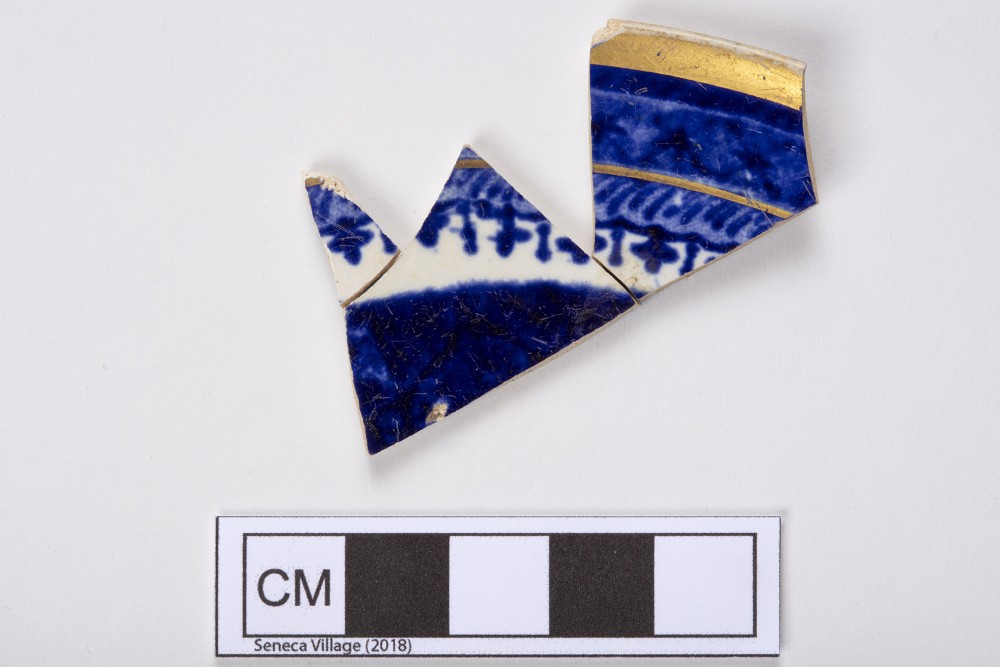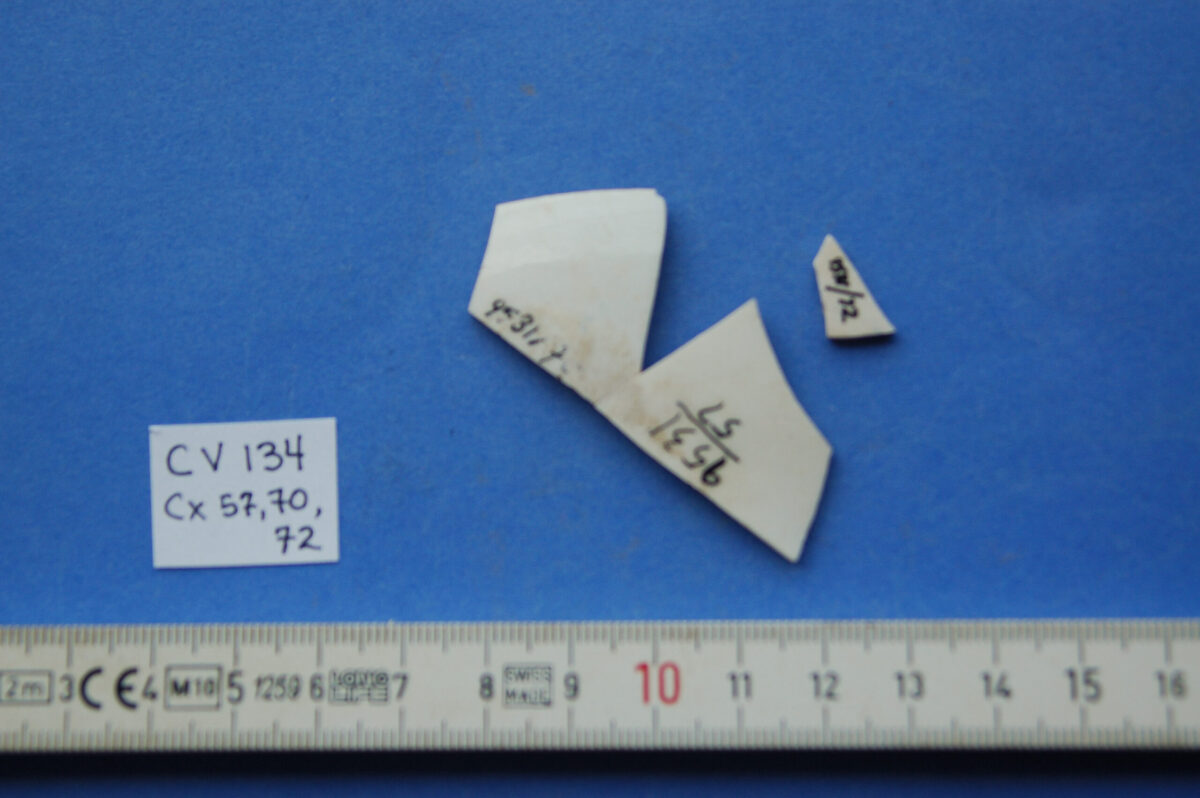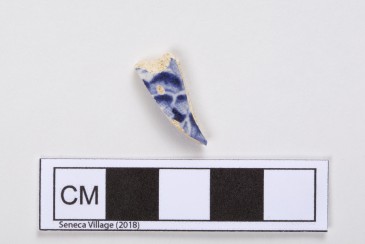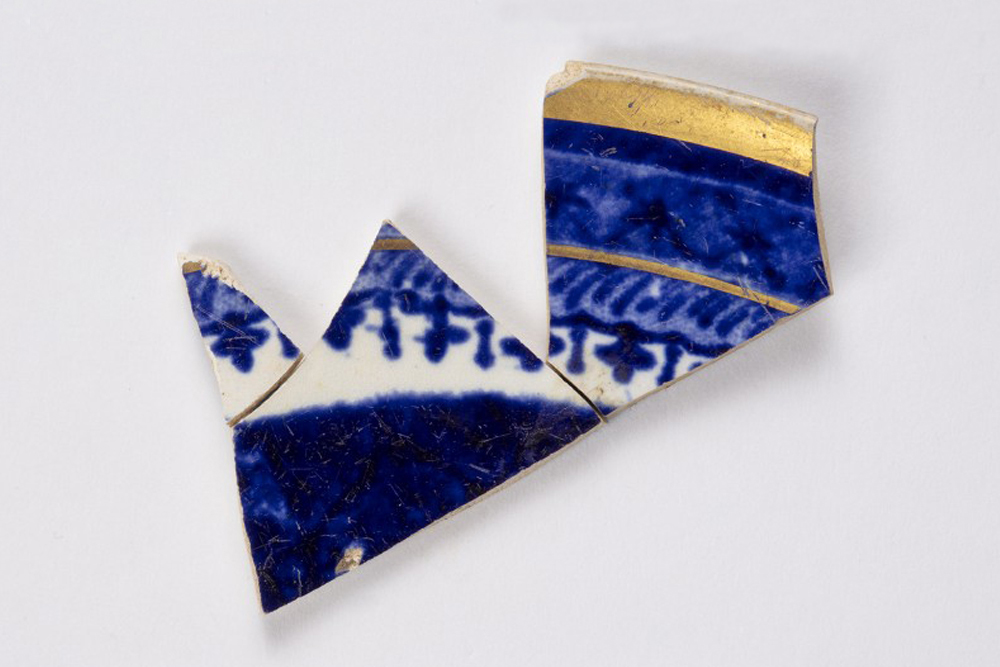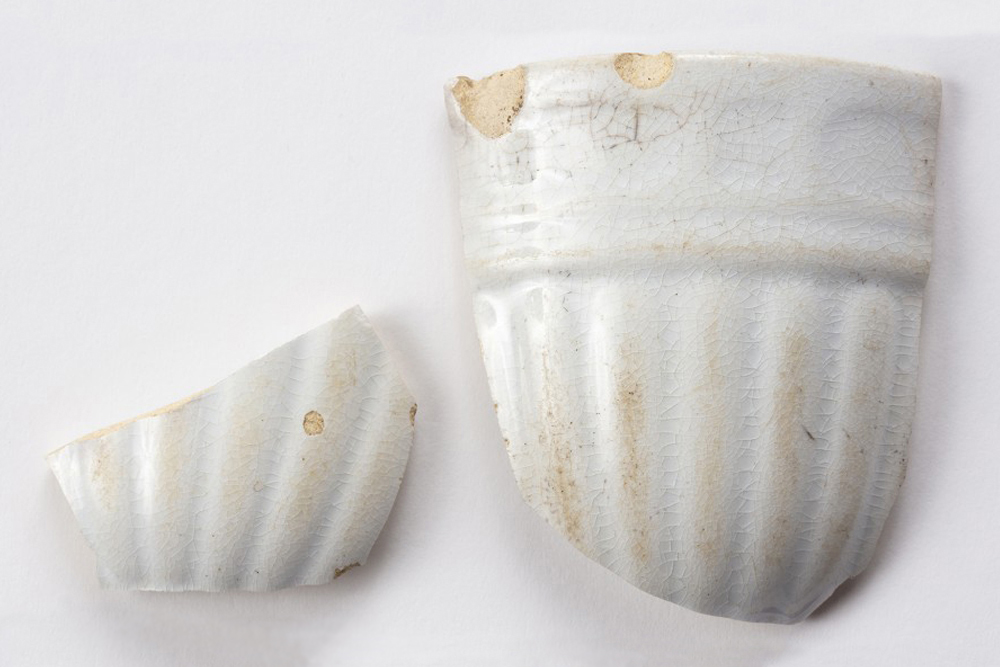Saucer
Tea was a popular beverage in America throughout the nineteenth century, becoming even more popular as it became cheaper and more accessible (Roth 1961). American “tea” (the event/social ritual), was adopted from Dutch and English roots and consisted of a social gathering that provided the opportunity to show off all of one’s manners, as well as one’s latest ceramic purchases. Thus, it was quite an effective tool for communicating wealth and class. Finally, we know that during the nineteenth century, social and economic changes affected how middle-class women were expected to appear and behave to fit into the familial structure (the “cult of domesticity”). Serving tea became an important aspect of fulfilling that new role, making it an especially interesting phenomenon to look into when attempting to understand nineteenth-century America.
To more fully understand the importance of tea, it is worth exploring what it came to represent during the nineteenth century, especially in regard to women. Why were women viewed in this new light? Why tea and not other beverages that were also accessible and popular at the same time? How was it that tea came to be associated with the values surrounding the “cult of domesticity”?
The answers to these questions are complicated, but some can be found in the history of the Second Great Awakening. The Second Great Awakening was a period of religious revival across America stretching from the late 1700s to the early 1800s. The “awakening” had many notable characteristics, but is relevant in that it caused the country to not only become more religious, but focused on the idea that people were not predestined to be good or evil, instead having the ability to make choices–to sin and to repent. Thus, the movement increased concerns about purity, morality, and atoning for one’s sins, kicking off a number of attempts at social reform. It appealed directly to women and elevated them to positions of moral authority–positions previously occupied by men–leading to a tremendous increase in women’s involvement in the church (specifically Methodists, Baptists, and new evangelical churches) and in religious life more generally. These ideas put the emerging idea of the ‘cult of domesticity’ in context and illustrate how, beyond the already considerable expectations placed on women, the awakening layered on the expectation of being the moral and religious center of the home (The Editors of the Encyclopedia Britannica 2019).
Entwined in and influenced by the influx of social-reform-oriented religiosity, the temperance movement took hold by the 1830s. Essentially, the temperance movement linked alcohol with a lack of religious and family values and advocated for people to pledge abstinence, pushing for legislation to be passed that would limit both the consumption and availability of alcohol (The Editors of the Encyclopedia Britannica 2018). When alcohol was no longer seen as a social beverage but an immoral vice, tea, already backed by its history as an upper-class social ritual, became an important symbol of morality and civility.
Given how tied up the concept of civility is in the ideas surrounding tea, it requires some examination. Civility means politeness, following etiquette, and, at this point in history, signaling “goodness” at a time when religiosity and social reform efforts were strongly focused on propriety and the appearance of social and moral order over structural societal changes. The complex meanings of civility have often been used to justifying inequality. For example, during America’s early history, which began with encroaching on indigenous lands and abusing indigenous peoples, the actions of European colonists were seemingly justified because they were “civilized” (religious, regimented, white), while indigenous peoples were not. This rationalization persisted as a justification for slavery and for treating African Americans and people of color on the whole as second-class citizens throughout America’s history. The same argument has been used to justify looking down on lower- and working-class people. Thus, I began to wonder if people spent money on luxury ceramics and time performing the etiquette of tea not only because of its supposed moral benefits and entertainment value, but to be accepted by others as “civil”. This may have been particularly true for the majority middle- and working-class African-American families of Seneca Village.
So what is this object?
The ceramic object is three fragments, totaling only a few centimeters in size when pieced together, from a saucer or small plate. These fragments were excavated from the site of Seneca Village on the buried ground surface, once a yard between the Webster and Philips family houses. The plate was most likely part of one of these family’s “fancy,” or specially-curated, tea sets. If it is not a saucer, which were designed specifically to hold teacups, but a small plate, it still could have been used to hold any number of small snacks served alongside tea.
The plate is made of either soft-paste porcelain or bone china, signifying that it was most likely made in England and shipped to New York (Maryland Archaeological Conservation Laboratory 2016). Although the possibility that it could have been made in America or elsewhere in Europe cannot be entirely ruled out, the fragments’ most prominent features–the cobalt blue designs and gold gilding–suggest a similar origin. The blue designs are hand-painted–a more expensive way to decorate ceramics, especially after the invention of transfer printing in the late eighteenth century. Decorations and patterns like these were intentionally evocative of the hard-paste porcelain exported from China that served as inspiration for European and American ceramics. Additionally, gold stripes, which were also hand-painted with real gold, indicate a higher price point.
The style, techniques, and materials used in the creation of this saucer were quite popular and attainable at the time. Without a maker’s mark or scientific analysis of the specific clays, it might be impossible to determine its exact date and maker.
Seneca Village
This fragment was uncovered between the Webster family house and the Phillips family house, two African-American families who lived in Seneca Village. The Websters owned their property, including a house (valued by an 1855 census for $2000), while the Philips rented a much more modest house (valued by an 1855 census for $500), meaning these two households likely occupied different positions on the economic spectrum of the village. While it is more likely the object belonged to the middle-class Webster family, such an object could still be a possession of the Phillipses. The other ceramics found in between the Webster and Phillips houses–the unearthed teacups, saucers, small plates, and kettle–are mostly higher-grade ceramics, including porcelain, white granite, and transfer-printed whitewares, which are more often than not decorated with blue and white designs, not unlike those on the saucer fragment. In contrast, many of the plainer ceramics are in the form of plates and soup bowls–ceramics not associated with tea (Wall et al. 2018, Appendix B-16, B-17)–suggesting that one or both of the families had both a fancy tea service and a “regular” set of ceramics for routine meals.
Aligning with the broader narrative of “tea,” this pattern of artifacts suggests the women of both the Webster and Phillips households likely curated a set of “teaware,” ceramics that at first glance one might not expect to find outside of an upper-class household. In order to fit into their “wifely” and “maternal” roles, they brought etiquette and civility into the household and beautified the home with such ceramics. Whether this display of civility was a direct acceptance of the societal values around them or a conscious effort to fit into a society that valued “tea” is difficult to determine.
Parting Words
There is so much we still do not know about Seneca Village, and, beyond that, much we do not have the ability to find out. I am curious about how tea, in country after country, managed to make its presence so visible. I want to know who the Websters and the Phillipses really were: did they spend excess money on nicer bits of pottery to conform to social norms or because they enjoyed/admired the beauty of ceramics? Was tea, for the Websters and Phillipses, a grueling social ritual, or did they love getting to entertain guests? Was tea adopted as a conscious attempt at fitting into the idea of “civility” purported by the white upper and middle classes? Without direct written testimony from these families, we can only make inferences at the role of tea in their personal lives, but I do hope you as a reader have learned enough about tea’s history and social trends, as well as about the porcelain fragments, to consider the role tea could have played in the lives of the Websters, the Phillipses, and Seneca Village in the midst of nineteenth-century America.
Works Cited
“Bone China.” 2016. Maryland Archaeological Conservation Laboratory. https://apps.jefpat.maryland.gov/diagnostic/Porcelain/PorcelainWareDescriptions/BoneChina-intro.html.
Cantwell, Anne-Marie, and Diana diZerega Wall. 2001. Unearthing Gotham: The Archaeology of New York City. New Haven: Yale University Press.
Carver, Beth. 2020. “Coffee, Tea, and Chocolate in Early Colonial America.” The Metropolitan Museum of Art. https://www.metmuseum.org/toah/hd/coff/hd_coff.htm.
Modianot-Fox, Dina. 3 Aug, 2020. “Tea’s Time.” Smithsonian Magazine. http://www.smithsonianmag.com/history/teas-time-146624691/.
“Nanking Porcelain.” 14 Mar, 2002. Encyclopedia Britannica. https://www.britannica.com/art/Nanking-porcelain.
New York City Archaeological Repository: The Nan A. Rothschild Research Center. 2020. “Seneca Village.” NYC Landmarks Preservation Commission, New York, NY. http://archaeology.cityofnewyork.us/collection/map/seneca-village.
New York State Census (NYSC). 1855. Seneca Village.
Rappaport, Eriak. 2017. A Thirst for Empire, How Tea Shaped the Modern World. Princeton: Princeton University Press.
Roth, Rodris. 1961. “Tea Drinking in 18th-Century America: Its Etiquette and Equipage.” United States National Museum Bulletin 225, 61-91.
“Second Great Awakening | Description, History, & Key Figures.” 2019. Encyclopedia Britannica. https://www.britannica.com/topic/Second-Great-Awakening.
Shadel, Jane S. 1971. “Documented Use of Cup Plates in the Nineteenth Century.” Journal of Glass Studies 13: 128-33.
“Soft Paste Porcelain.” 2016. Maryland Archaeological Conservation Laboratory. https://apps.jefpat.maryland.gov/diagnostic/Porcelain/PorcelainWareDescriptions/SoftPastePorcelain-intro.html.
“Temperance Movement | Definition, Leaders, Facts, & Significance.” 2018. Encyclopedia Britannica. https://www.britannica.com/topic/temperance-movement.
Wall, Diana diZerega. 1991. “Sacred Dinners and Secular Teas: Constructing Domesticity in Mid-19th-Century New York.” Historical Archaeology 25, no. 4: 69–81.
Wall, Diana diZerega, Nan A. Rothschild, Meredith B. Linn, and Cynthia R. Copeland. 2018. “Seneca Village, A Forgotten Community: Report on the 2011 Excavations.” New York, NY: Institute for the Exploration of Seneca Village History, Inc. A report submitted to NYC Landmarks Preservation Commission, the Central Park Conservancy, and the NYC Department of Parks and Recreation.

